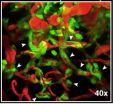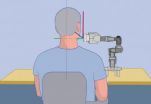(Press-News.org) Pneumonia – a severe lung infection – is the most common disease calling for hospital admission. More than one out of ten pneumonia patients die of the disease. Thus it is vital to accurately predict and closely monitor the clinical course. Here, measuring the respiratory rate – the number of breaths a person takes in a minute – provides valuable information. However, far too little use is still being made of this vital sign in clinical practice, as Richard Strauß and co-authors conclude in their recent study in Deutsches Ärzteblatt (Dtsch Arztebl Int 2014; 111: 503).
The respiratory rate has long been established as an important prognostic factor and aid to risk evaluation. For example, it was already known in the 1980s that pneumonia patients with increased respiratory rates were more likely to die than their counterparts with normal breathing. Despite recommendations to measure the respiratory rate in several diseases, it is still underutilized in hospitals, the study reveals. Although the respiratory rate is usually determined when pneumonia treatment is started, regular measurements and consistent documentation are rare. But counting the breaths in pneumonia patients should, as the authors point out, be as much of a routine as taking the pulse and measuring the blood pressure is today.
INFORMATION:
http://www.aerzteblatt.de/pdf.asp?id=161152
Prognosis of pneumonia: value of respiratory rate often overlooked
2014-08-12
ELSE PRESS RELEASES FROM THIS DATE:
Hijacking the brain's blood supply: tumor discovery could aid treatment
2014-08-12
ANN ARBOR, Mich. — Dangerous brain tumors hijack the brain's existing blood supply throughout their progression, by growing only within narrow potential spaces between and along the brain's thousands of small blood vessels, new research shows for the first time.
The findings contradict the concept that brain tumors need to grow their own blood vessels to keep themselves growing – and help explain why drugs that aim to stop growth of the new blood vessels have failed in clinical trials to extend the lives of patients with the worst brain tumors.
In fact, trying to ...
Lead released from African cookware contaminates food
2014-08-12
San Francisco and Yaoundé – Lead levels in foods prepared in aluminum pots from Cameroon exceed U.S. guidelines for lead consumption according to a new study published this month. A typical serving contains almost 200 times more lead than California's Maximum Allowable Dose Level (MADL) of 0.5 micrograms per day.
Researchers at Ashland University and Occupational Knowledge International tested 29 samples of aluminum cookware made in Cameroon and found almost all had considerable lead content. This cookware is common throughout Africa and Asia and is made from recycled ...
Changes in motor function in the unaffected hand of stroke patients should not be ignored
2014-08-12
With effective rehabilitation, stroke patients can partially regain their motor control and continue their activities of daily living. Motor function changes in the unaffected hand of stroke patients with hemiplegia. However, these changes are often ignored by clinicians owing to the extent of motor disability of the affected hand. Research group at Shanghai University of Sport, China led by Prof. Zhusheng Yu based on finger tapping frequency and Lind-mark hand function score have found that the motor function of unaffected hands in stroke patients was poorer than that ...
Neuroprotective effect of tongxinluo: a PET imaging study in small animals
2014-08-12
Tongxinluo has been widely used in China for the treatment of acute stroke and for neuroprotection. Research group at Encephalopathy Center, Guangdong Provincial Hospital of Traditional Chinese Medicine, China intragastrically administered Tongxinluo superfine powder suspension or its vehicle to rats for 5 successive days before middle cerebral artery occlusion. There are many advantages of using small animal PET for drug research. First, the results of the study in vitro cannot be directly applied to human studies, while small animal PET imaging methods and results can ...
ASU-Mayo researchers use calcium isotope analysis to predict myeloma progression
2014-08-12
TEMPE, Ariz. – A team of researchers from Arizona State University and Mayo Clinic is showing how a staple of Earth science research can be used in biomedical settings to predict the course of disease.
The researchers tested a new approach to detecting bone loss in cancer patients by using calcium isotope analysis to predict whether myeloma patients are at risk for developing bone lesions, a hallmark of the disease.
They believe they have a promising technique that could be used to chart the progression of multiple myeloma, a lethal disease that eventually impacts ...
Neutrino detectors could help curb nuclear weapons activity
2014-08-12
Physicists at the Large Hadron Collider in Switzerland and even in the fictional world of CBS' "The Big Bang Theory" look to subatomic particles called neutrinos to answer the big questions about the universe.
Now, a group of scientists led by a physics professor with the College of Science at Virginia Tech are asking whether the neutrino could provide the world with clues about nuclear proliferation in Iran and other political hotspots.
Neutrinos are produced by the decay of radioactive elements, and nuclear reactors produce large amounts of neutrinos that cannot ...
Focal blood-brain-barrier disruption with high-frequency pulsed electric fields
2014-08-12
A team of researchers from the Virginia Tech-Wake Forest University School of Biomedical Engineering and Sciences have developed a new way of using electricity to open the blood-brain-barrier (BBB). The Vascular Enabled Integrated Nanosecond pulse (VEIN pulse) procedure consists of inserting minimally invasive needle electrodes into the diseased tissue and applying multiple bursts of nanosecond pulses with alternating polarity. It is thought that the bursts disrupt tight junction proteins responsible for maintaining the integrity of the BBB without causing damage to the ...
A highly sensitive microsphere-based assay for early detection of Type I diabetes
2014-08-12
A team of researchers from the Center for Engineering in Medicine at the Massachusetts General Hospital have developed a novel fluorescence-based assay for sensitive detection of antibodies within microliter volume serum samples. This new assay is at least 50 times more sensitive than the traditional radioimmunoassay (RIA), which is the gold standard currently used in the clinic. This new technology is particularly attractive for immunological assays as it allows: 1) use of very small volumes of sample reagents (5 ¦ÌL), and 2) use of traditional analytical systems such ...
Biomarker could reveal why some develop post-traumatic stress disorder
2014-08-12
(NEW YORK – August 11) Blood expression levels of genes targeted by the stress hormones called glucocorticoids could be a physical measure, or biomarker, of risk for developing Post-Traumatic Stress Disorder (PTSD), according to a study conducted in rats by researchers at the Icahn School of Medicine at Mount Sinai and published August 11 in Proceedings of the National Academy of Sciences (PNAS). That also makes the steroid hormones' receptor, the glucocorticoid receptor, a potential target for new drugs.
Post-Traumatic Stress Disorder (PTSD) is triggered by a terrifying ...
Robotic-assisted imaging: from trans-Atlantic evaluation to help in daily practice
2014-08-12
While in Germany, Partho P. Sengupta, MD, of Icahn School of Medicine at Mount Sinai used a computer to perform a robot-assisted trans-Atlantic ultrasound examination on a person in Boston. In another study Kurt Boman, MD, of Umeå University in Sweden in collaboration with Mount Sinai, showed how a cardiologist's video e-consultation, coupled with a remote robot-assisted echocardiogram test, dramatically reduces the waiting time for a diagnosis faced by heart failure patients who live in a rural communities far from the hospital from nearly four months to less than one ...




